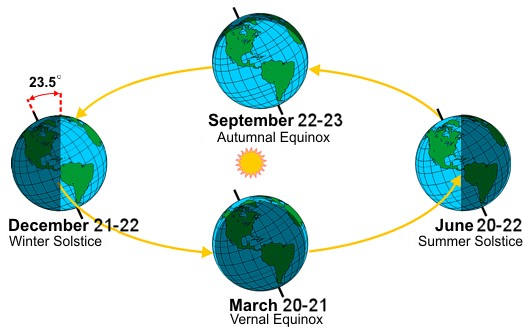
The March equinox happens at 3:06 UTC on March 20, 2024 (10:06 p.m. CDT on March 19.)
The equinox sun rises due east and sets due west
It’s not true that day and night are precisely equal on the day of an equinox. But here’s an equinox fact that is true. The sun rises due east and sets due west at the equinox. It might seem counterintuitive. But it’s true no matter where you live on Earth (except at the North and South Poles). Here’s how to visualize it.
To understand the nearly due-east and due-west rising and setting of an equinox sun, you have to think of the reality of Earth in space. First think about why the sun’s path across our sky shifts from season to season. That’s because our world is tilted on its axis with respect to its orbit around the sun.
Join us in making sure everyone has access to the wonders of astronomy. Donate now!

Now think about what is an equinox. It’s an event that happens on the imaginary dome of Earth’s sky. And it marks that special moment when the sun crosses the celestial equator going from one hemisphere to the other. Of course, it also represents a point in Earth’s orbit.
The celestial equator
The celestial equator is a great circle dividing the imaginary celestial sphere into its northern and southern hemispheres. Additionally, the celestial equator wraps the sky directly above Earth’s equator. Following the September equinox, the sun crosses the celestial equator to enter the sky’s Southern Hemisphere.
All these components are imaginary, yet what happens at every equinox is very real. In fact, it’s as real as the sun’s passage across the sky each day and as real as the change of seasons.
It’s the same all over the globe
So no matter where you are on Earth (except for the North and South Poles), you have a due east and due west point on your horizon. That point marks the intersection of your horizon with the celestial equator, the imaginary great circle above the true equator of Earth.
And that’s why the sun rises close to due east and sets close to due west, for all of us, at the equinox. The equinox sun is on the celestial equator. Which means, no matter where you are on Earth, the celestial equator intersects your horizon at due east and due west.
This fact makes the day of an equinox a good day for finding east and west from your yard or favorite site for watching the sky. Just go outside around sunset or sunrise and notice the location of the sun on the horizon with respect to familiar landmarks.
If you do this, you’ll be able to use those landmarks to find those cardinal directions in the weeks and months ahead. Plus, you’ll know those directions long after Earth has moved on in its orbit around the sun.
The history of the seasons
Our ancestors may not have understood the equinoxes and solstices as events that occur during Earth’s yearly orbit around the sun. But if they were observant – and some were very observant indeed – they surely marked the day of the equinox as being midway between the sun’s lowest path across the sky in winter and highest path across the sky in summer.
Now we can say with reasonably high accuracy that the sun rises due east and sets due west on the day of the equinox. And this is the same for everyone around the globe.
If you are seeking more precision for the sunrise/sunset direction in your part of the world, check out the altitude/azimuth for the sun via timeanddate.com.

Bottom line: The 2024 March equinox occurs on March 20 at 3:06 UTC (10:06 p.m. CDT on March 19). At the equinox, the sun rises and sets due east and due west.











